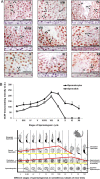Germ Cell Nuclear Factor (GCNF/RTR) Regulates Transcription of Gonadotropin-Regulated Testicular RNA Helicase (GRTH/DDX25) in Testicular Germ Cells--The Androgen Connection
- PMID: 26484580
- PMCID: PMC4664233
- DOI: 10.1210/me.2015-1198
Germ Cell Nuclear Factor (GCNF/RTR) Regulates Transcription of Gonadotropin-Regulated Testicular RNA Helicase (GRTH/DDX25) in Testicular Germ Cells--The Androgen Connection
Abstract
Gonadotropin-regulated testicular RNA helicase (GRTH) (GRTH/DDX25), is a testis-specific protein essential for completion of spermatogenesis. Transgenic mice carrying 5'-flanking regions of the GRTH gene/green fluorescence protein (GFP) reporter revealed a region (-6.4/-3.6 kb) which directs its expression in germ cells (GCs) via androgen action. This study identifies a functional cis-binding element on the GRTH gene for GC nuclear factor (GCNF) (GCNF/RTR) required to regulate GRTH gene expression in postmeiotic testis GCs and explore the action of androgen on GCNF and GRTH transcription/expression. GCNF expression decreased in mice testis upon flutamide (androgen receptor antagonist) treatment, indicating the presence of an androgen/GCNF network to direct GRTH expression in GC. Binding studies and chromatin immunoprecipitation demonstrated specific association of GCNF to a consensus half-site (-5270/-5252) of the GRTH gene in both round spermatids and spermatocytes, which was abolished by flutamide treatment in round spermatids. Moreover, flutamide treatment of wild-type mice caused selective reduction of GCNF and GRTH in round spermatids. GCNF knock-down in seminiferous tubules from GRTH-transgenic mice (dark zone, round spermatid rich) caused decreased GFP expression. Exposure of tubules to flutamide caused decrease in GCNF and GFP expression, whereas androgen exposure induced significant increase. Our studies provide evidence for actions of androgen on GCNF cell-specific regulation of GRTH expression in GC. GRTH associates with GCNF mRNA, its absence caused increase on GCNF expression and mRNA stability indicative of a negative autocrine regulation of GCNF by GRTH. These in vivo/in vitro models link androgen actions to GC through GCNF, as regulated transfactor that controls transcription/expression of GRTH.
Figures







Similar articles
-
Gonadotropin Regulation Testicular RNA Helicase, Two Decades of Studies on Its Structure Function and Regulation From Its Discovery Opens a Window for Development of a Non-hormonal Oral Male Contraceptive.Front Endocrinol (Lausanne). 2019 Aug 29;10:576. doi: 10.3389/fendo.2019.00576. eCollection 2019. Front Endocrinol (Lausanne). 2019. PMID: 31555207 Free PMC article. Review.
-
A 5'-flanking region of gonadotropin-regulated testicular RNA helicase (GRTH/DDX25) gene directs its cell-specific androgen-regulated gene expression in testicular germ cells.Endocrinology. 2013 Jun;154(6):2200-7. doi: 10.1210/en.2012-2230. Epub 2013 Apr 1. Endocrinology. 2013. PMID: 23546600 Free PMC article.
-
Cell-specific and hormone-regulated expression of gonadotropin-regulated testicular RNA helicase gene (GRTH/Ddx25) resulting from alternative utilization of translation initiation codons in the rat testis.J Biol Chem. 2003 Jul 25;278(30):27796-803. doi: 10.1074/jbc.M302411200. Epub 2003 May 6. J Biol Chem. 2003. PMID: 12734186
-
Gonadotropin-regulated testicular RNA helicase (GRTH/DDX25) gene: cell-specific expression and transcriptional regulation by androgen in transgenic mouse testis.J Cell Biochem. 2010 Apr 15;109(6):1142-7. doi: 10.1002/jcb.22493. J Cell Biochem. 2010. PMID: 20108248
-
Gonadotropin-regulated testicular RNA helicase (GRTH/DDX25): a multifunctional protein essential for spermatogenesis.J Androl. 2010 Jan-Feb;31(1):45-52. doi: 10.2164/jandrol.109.008219. Epub 2009 Oct 29. J Androl. 2010. PMID: 19875492 Free PMC article. Review.
Cited by
-
What Does Androgen Receptor Signaling Pathway in Sertoli Cells During Normal Spermatogenesis Tell Us?Front Endocrinol (Lausanne). 2022 Feb 24;13:838858. doi: 10.3389/fendo.2022.838858. eCollection 2022. Front Endocrinol (Lausanne). 2022. PMID: 35282467 Free PMC article. Review.
-
Characterization of the Phosphorylation Site of GRTH/DDX25 and Protein Kinase A Binding Interface Provides Structural Basis for the Design of a Non-Hormonal Male Contraceptive.Sci Rep. 2019 Apr 30;9(1):6705. doi: 10.1038/s41598-019-42857-9. Sci Rep. 2019. PMID: 31040297 Free PMC article.
-
Hormone receptor 4 is required in muscles and distinct ovarian cell types to regulate specific steps of Drosophila oogenesis.Development. 2021 Mar 9;148(5):dev198663. doi: 10.1242/dev.198663. Development. 2021. PMID: 33547134 Free PMC article.
-
DEAD-Box Helicase DDX25 Is a Negative Regulator of Type I Interferon Pathway and Facilitates RNA Virus Infection.Front Cell Infect Microbiol. 2017 Aug 4;7:356. doi: 10.3389/fcimb.2017.00356. eCollection 2017. Front Cell Infect Microbiol. 2017. PMID: 28824886 Free PMC article.
-
Gonadotropin Regulation Testicular RNA Helicase, Two Decades of Studies on Its Structure Function and Regulation From Its Discovery Opens a Window for Development of a Non-hormonal Oral Male Contraceptive.Front Endocrinol (Lausanne). 2019 Aug 29;10:576. doi: 10.3389/fendo.2019.00576. eCollection 2019. Front Endocrinol (Lausanne). 2019. PMID: 31555207 Free PMC article. Review.
References
-
- Sheng Y, Tsai-Morris CH, Dufau ML. Cell-specific and hormone-regulated expression of gonadotropin-regulated testicular RNA helicase gene (GRTH/Ddx25) resulting from alternative utilization of translation initiation codons in the rat testis. J Biol Chem. 2003;278:27796–27803. - PubMed
-
- Dufau ML, Tsai-Morris CH. Gonadotropin-regulated testicular helicase (GRTH/DDX25): an essential regulator of spermatogenesis. Trends Endocrinol Metab. 2007;18:314–320. - PubMed
-
- Sheng Y, Tsai-Morris CH, Gutti R, Maeda Y, Dufau ML. Gonadotropin-regulated testicular RNA helicase (GRTH/Ddx25) is a transport protein involved in gene-specific mRNA export and protein translation during spermatogenesis. J Biol Chem. 2006;281:35048–35056. - PubMed
Publication types
MeSH terms
Substances
Grants and funding
LinkOut - more resources
Full Text Sources
Other Literature Sources
Molecular Biology Databases
Miscellaneous

